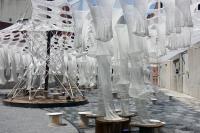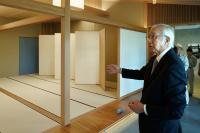RESET Apartment
Beijing, China
Context
The lifestyles of young professionals have not been settling down. They are bored of the stereotypical room-cell layout. However, their newly-developed hobbies, social modes have still not been included in the existing concept of the “home“ and therefore not able to find their unique expression of a lived space.
META-Project believes that changes in the cultural program of contemporary city will determine the transformation of individual living space.
People that live in a “room“, are living in the “city“ in the first place. 10 years ago, it is impossible to imagine what kind of cultural life would take place in the city right now. Beijing has been experiencing an ultra-intensive urban evolution, especially since the 2008 Olympic Games. Sunlitun, 798, GongTi - hustling culture creates a new 24-hour city; renovation of historical areas are constantly filling the “brimming “city; and new public festivals display an alternative “invisible city“.
When he chooses online shopping instead of shopping outside, when he prefers DVD, XBOX over theaters and cinema; when he invites his friends to come over to eat, chat and play games; when he holds his own fossil exhibition at home, and even turns the room into a cafe, a bar, a dance club, a meeting room, an office...all his everyday experience of urban program are extended into this room, becoming part of his life.
For many years, META-Project has been focusing on the transformation of contemporary urban culture, and exploring possible spatial mutations it generates.
Usage
The brief is basic: to design a spatial layout that is adaptive according to the inhabitant’s various usages.
Counter-intuitively, this task is highly complicated because of the complexity and unpredictability of everyday life.
To start with the design , we first conducted a detailed documentation of the current usage status, based on which a careful planning of various possible events is projected. We had in-depth interviews with the owner, obtained a 24-hour record of his daily activities for 2 weeks, specified to duration, dimension of space occupied, and number of people involved. Records and interviews are organized into tables as an important design basis.
META-Project always believes that the understanding of individual space and that of contemporary cities are both established on the in-depth knowledge of the multiplicity of events occurred. This knowledge, could only be obtained from comprehensive documentation of the reality, then thorough analysis of the recorded data, to reveal the operating mechanism behind the events. Our target is to reflect and evoke contemporary way of life by designing new spatial typology through simulation, adaptation and evolution.
Unless the existing residential typology is altered, design cannot meet the needs for the coming generation!
The 24-hour life log is translated into a graphic chart, in which the horizontal axis means time-lapse, while vertical reflects usage intensity (UI):
UI = Occupied Area x Number of People Involved
The UI is defined to reflect the actual density of human activities. The chart reveals the distribution pattern: The owner has such a lifestyle that it constantly swings between two extreme layouts of “public“ and “private“ . Every morning and night, private space functions primarily to accommodate individual activities such as sleeping/washing/ dining and working/reading/experiment/meditation; while in the afternoon, the room is transformed into an entire public space, especially on weekends. The owner and his friends enjoy in meeting, playing games and at times turning the apartment to a party place!
The concept of RESET Apartment is born!
Reset
The concept of RESET is necessary for allowing all programs to co-exist in the same space.
The RESET Apartment functions as its name suggests: it can be arranged in many different ways according to the inhabitant’s usage, but when needed, it can be reset to the initial - most empty stage in a flash time.
The owner of this apartment has such a lifestyle that it requires two extreme layout to co-exist: at one hand the intention to leave the space as empty as possible, so it can be a public/event space; at the other hand the preference to maximize the flexibility of the space at no compromise of the amenities to serve all his life/hobbies, from the basics – bed /toilet/ shower cube / kitchenette, to working desk / meeting lounge /experiment lab / library / fish tank / cabinet for his collections / video gaming, and at times to turn the apartment entirely to a party place!
Once in a while, like pushing the ‘reset’ button, the apartment goes back to an empty studio, allowing all kinds of activities to unravel again.
We have condensed all functions into two groups: the “living” and the “extra-living”, each group is built into one corner of the room as multiple movable wall-shelf units, like the library shelves. By using a simple mechanism, the group-form arrangement has effectively answered the inhabitant’s multiple needs to a single space.
Object
The owner has a lot of stuff, and it’s messy.
Before starting to design the wall cabinet units of different functions, we have made an inventory of these objects. The statistics includes item classification, number, size, weight, and suitable way of placement. We also estimated the expanding rate.
Items are divided into eight basic categories:
Clothes and bedding
Kitchenware and Tableware
Books
Domestic Appliances
Audio-Video Multimedia
Collections and Experiment Supplies
Groceries
Furniture
These seven categories are further divided into two function parts: “living” and “extra-living”. Items of “living“ are stored in one side of the entrance and can be slide along the line, on the other hand, “extra-living“ group of items could be polled out of different units of cabinets when necessary, and meet multifunctional needs by recombining.
Sequence
The concept of RESET generates an infinite “matrix“ of possibilities. Arranged to the time lapse, the “matrix“ re-appears as a linear “sequence“ of programmed layouts.
Inhabitants are able to (re)arrange the RESET Apt. according to the flexible order of daily events. Every 24-hour is a non-repeated cycle. The uncertainty of everyday life leads to the multiplicity of ”sequence”. Different event may occur at the same time. Therefore, the vertical axis of the sequence represents various possiblities, followed with a series of corresponding results. From this perspective, the 38 layouts in the “sequence” represent only certain anchor points of the reality, from which similar programs can be derived.
Moreover, the “sequence” has taken into account different scenarios of single user, double user and multi-user. Parallel (or cross) multiple trajectories was linked following different number of users. Even the same program, such as dining or watching movies, may result in different layout modes due to different occupancy.
Scenario
The “scenario“ is the spatial experience of each layout in the sequence.
Each scenario is not fixed, but dynamic, transient and changed in a flash moment. Like the change of the sunlight, the spatial experience is also constantly changing.
Starting from the initial open studio, with each pushes and pulls and the introduction of each unit, the whole space is divided into a number of “sub-spaces”. Defined by its spatial scales and adjacent cabinet units, the sub-spaces have different levels of public - private attributes, as well as different programs. With the movement of units, these “sub-spaces” interchange position and alter properties constantly.
This mechanism is like a three-dimensional everyday version of “klotski”, its movement reveals a stunning spatial variations. In particular, due to the different permeability of wall cabinet units, the scenarios present unexpected changes in light, which could never be achieved by any fixed design.














